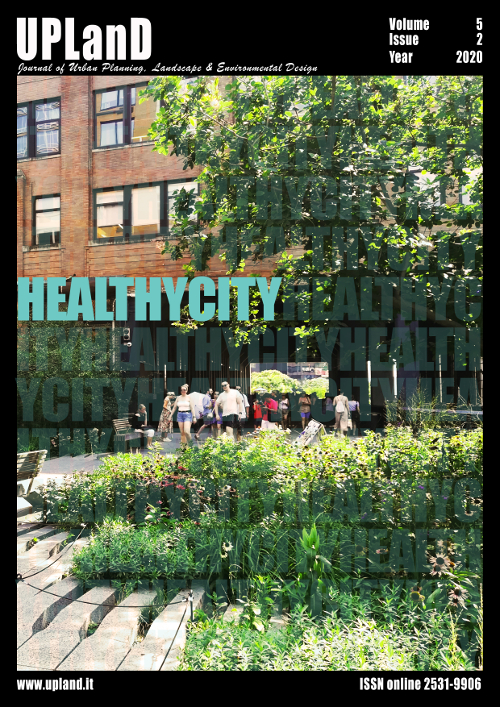The European transhumance network The ancestral infrastructuring of the territory for settlement rebalance in post-pandemic society
Main Article Content
Abstract
The lockdown caused by the Covid-19 outbreak was an involuntary socio-environmental experiment demonstrating that the conditions exist to pursue alternative solutions to our short-sighted economic-productive system.
Long neglected themes have returned to the center of the debate: the potential of inland areas in the policies of redistribution of settlement density; the value, not only cultural, of secondary historical settlements; the enhancement of ecosystem services due to large-area environmental systems; the role of urban spaces and proximity green spaces for the sustainability of dense settlements.
For all these issues, the transhumance system has played a central role over time.
In this new scenario, the article reports on a research effort aimed at defining a territorial model for the European transhumance network.
The territorial system of transhumance, observed according to the taxonomic hierarchy proposed by the research, will be able to constitute a knowledge base for implementing policies for the conservation of customs, traditions, beliefs, food and wine culture, and expression of the pastoral world.
Furthermore, the system may become a coherent framework aimed at assessing the environmental and landscape sustainability of rebalancing settlement transformations in a climate-proof way, with particular reference to the new mobility strategies and new settlement choices that will become appropriate in the post-pandemic era.
Downloads
Article Details

This work is licensed under a Creative Commons Attribution-NonCommercial-NoDerivatives 4.0 International License.
Authors who publish with this journal agree to the following terms:- Authors retain copyright and grant the journal right of first publication with the work simultaneously licensed under a Creative Commons Attribution License that allows others to share the work with an acknowledgement of the work's authorship and initial publication in this journal.
- Authors are able to enter into separate, additional contractual arrangements for the non-exclusive distribution of the journal's published version of the work (e.g., post it to an institutional repository or publish it in a book), with an acknowledgement of its initial publication in this journal.
- Authors are permitted and encouraged to post their work online (e.g., in institutional repositories or on their website) prior to and during the submission process, as it can lead to productive exchanges, as well as earlier and greater citation of published work (See The Effect of Open Access).
References
Braudel, F. (1965). Civiltà e imperi del Mediterraneo nell'età di Filippo II, (1949). Torino, IT: Einaudi Editore.
Braudel, F., (2017). Il mediterraneo. Milano, IT: Bompiani.
Calzolai, L. (2007). Pratomagno e Maremma. Allevamento e transumanza in Annali Aretini, XV-XVI, 2007-2008, pp. 297-312.
Calzolai, L. (2018). Vie di animali e uomini. Gli itinerari della transumanza in Toscana. In Scanu G., (Ed.), Conoscere per rappresentare. Temi di cartografia e approcci metodologici. Trieste, IT: EUT Edizioni Università di Trieste.
Cano Delgado, J.J. (2018). La red caminera de Tenerife. Cabildo Insular de Tenerife, ES, Tenerife
Cialdea, D. (2015). Un’infrastruttura “primaria” nelle Regioni dell’Italia centro-meridionale: interventi per una Rigenerazione Territoriale. Urbanistica Informazioni, 278 (S.I.) 112-116.
Cristoferi, D. (2019). «…In passaggio, andando e tornando…»: per un quadro delle transumanze in Toscana tra XII e XV secolo. Rivista di Storia dell’Agricoltura, 54(1), 3-82.
Dell’Omodarme, O. (1996). Le dogane di Siena, di Roma e di Foggia: un raffronto dei sistemi di ’governo’ della transumanza in età moderna. Ricerche storiche, 26, 259-303.
Duclos, J.C., & Fabre, P. (2004). La grande transhumance ovine, une pratique méditerranéenne. Cartographie B. N. Esperguin. Conservation du patrimoine de l'Isère (CPI) Musée Dauphinois.
Favalli, M., & Pareschi, M.T. (2004). Digital elevation model construction from structured topographic data: The DEST algorithm. Journal of Geophysical Research, 109.
Manker, E. (1953). The Nomadism of the Swedish Mountain Lapps. The Siidas and their Migratory Routes in 1945. Nordiska Museet: Acta Lapponica, 7.
Marino, J.A. (1992). L'economia pastorale nel Regno di Napoli. Napoli, IT: Guida.
Núñez Pestano, J.R. (2004). Camino de Chasna. El Pajar: Cuaderno de Etnografía Canaria, 18, 9-15.
Pratesi, F. (2010). Storia della natura d'Italia. Soveria Mannelli, IT: Rubbettino.
Quilici, L. (1979). Roma primitiva. Roma, IT: Newton Compton.
Sigismondi, F.L. (2011). La disciplina del pascolo e i ’danni dati’ negli statuti laziali della prima età moderna. In A. Mattone & P.F. Simbula (Eds.), La pastorizia mediterranea: storia e diritto (secoli XI-XX). Roma, IT: Carocci.
Valorani, C. (2016). L'idea del ’distretto di paesaggio’ per la cura del paesaggio ’bene comune’. Agribusiness Paesaggio & Ambiente, 18(3), 236-240.
Valorani, C. (2018). La rete europea dei percorsi di transumanza. Il caso dell’area laziale in Urbanistica Informazioni, 278(S.I.), 112-116.
Volpi, A. (2020-pre-print). Dai Monti Simbruini verso la Campagna Romana e l'Agro Pontino in I giorni della storia. Seminario 4. La transumanza nel Lazio Meridionale, 29 nov. 01 dic. 2019, Istituto di Storia e di Arte del Lazio Meridionale.

